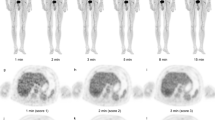Abstract.
Positron emission tomography (PET) has evolved into a technique that can accurately determine the distribution of positron-emitting radionuclides. The addition of a coincidence detection mode to a standard dual-head detector system has resulted in the option of single-photon and annihilation coincidence detection. This new device for imaging fluorine-18 2-fluoro-2-deoxy-D-glucose (18F-FDG) accumulation in neoplasms became commercially available in 1994. Besides conventional low-energy imaging in the collimated single-photon mode, it offers a relatively inexpensive opportunity to perform uncollimated PET by switching to the coincidence acquisition mode. This review summarises the clinical value of 18F-FDG detection with a dual-head coincidence camera in oncology. The results are compared with the overall results obtained using dedicated PET scanners. With respect to head and neck tumours, 18F-FDG coincidence mode gamma camera imaging (CGI) yields results that are in agreement with those obtained with dedicated PET scanners. With regard to other malignancies, such as lung cancer, lymphoma and brain tumours, data in the literature are too scarce to draw any definite conclusions. In general, the results of 18F-FDG CGI in tumours >15 mm seem to be comparable to those obtained with dedicated PET scanners, whereas in tumours <15 mm, the relative sensitivity of 18F-FDG CGI is approximately 80%. Using attenuation correction, the diagnostic yield of 18F-FDG CGI may increase. However, further clinical investigation is required to definitely establish its value in staging primary disease, therapy monitoring and assessment of tumour recurrence in clinical oncology.
Similar content being viewed by others
Author information
Authors and Affiliations
Additional information
Electronic Publication
Rights and permissions
About this article
Cite this article
Ak, I., Blokland, J., Pauwels, E. et al. The clinical value of 18F-FDG detection with a dual-head coincidence camera: a review. Eur J Nucl Med 28, 763–778 (2001). https://doi.org/10.1007/s002590100501
Published:
Issue Date:
DOI: https://doi.org/10.1007/s002590100501




